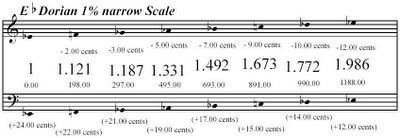 The F Lydian 1% Wide Scale.
The F Lydian 1% Wide Scale.
Saturday, July 30, 2005
Friday, July 29, 2005
Thursday, July 28, 2005
Wednesday, July 27, 2005
Tuesday, July 26, 2005
Monday, July 25, 2005
Neural Misfit
 It's about time to unleash some HurdAudio noise. I'm testing out the SoundClick option as a means for presenting sound connected to this blogging effort. I've posted Neural Misfit for the time being and look forward to placing a number of the "Scale of the Day" examples there in the near future.
It's about time to unleash some HurdAudio noise. I'm testing out the SoundClick option as a means for presenting sound connected to this blogging effort. I've posted Neural Misfit for the time being and look forward to placing a number of the "Scale of the Day" examples there in the near future.
Sunday, July 17, 2005
The Holy Ghost Speaks - Chapter 8
 Cracking open the sacred Holy Ghost Box set I find myself pouring disc 8 into open ears. Here Albert Ayler speaks as the final two discs of this collection present interviews from different periods of his life. Here Ayler spells out with traces of bewilderment an autobiographical
Cracking open the sacred Holy Ghost Box set I find myself pouring disc 8 into open ears. Here Albert Ayler speaks as the final two discs of this collection present interviews from different periods of his life. Here Ayler spells out with traces of bewilderment an autobiographical  explanation of his artistic sensibility in two brief interviews in Copenhagen, Denmark (1964 and 1966) and one long one in Saint-Paul-de-Vence, France in 1970.
explanation of his artistic sensibility in two brief interviews in Copenhagen, Denmark (1964 and 1966) and one long one in Saint-Paul-de-Vence, France in 1970.The most striking thing, for me, is the pervasive sense of isolation Ayler expresses at pursuing an honest musical sensibility in the face of a hostile cultural reception. Particularly poignant are the episodes when his own mother cannot recognize what Ayler is doing to the degree that she can no longer recognize Ayler as her own child. The pain of this experience feels fresh in the delivery of this account.
It was also interesting to hear how his experiences in playing in the army made it clear to Ayler that he would find more sympathetic ears in Europe (particularly in Sweden). Even through the pervasive artistic and spiritual isolation Ayler was constantly seeking out sympathetic souls and ears. And hearing accounts of playing with John Coltrane, Eric Dolphy, Cecil Taylor and Sonny Murray is a fantastic documentation of this period of creative explosion in jazz improvisation. These sympathetic minds that encouraged Ayler's music as they pursued similar journeys of their own. Ayler refers to Charles Ives as "the greatest American composer." This is still true half a century later. I can see why this artist continues to resonate to this day.
Saturday, July 16, 2005
Pika-Don
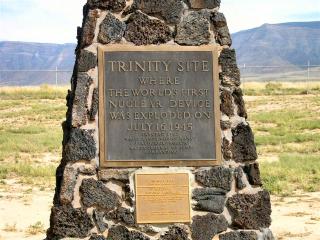 Today is the 60th anniversary of the first atomic explosion at the Alamogordo test site in New Mexico. This history-altering event and the subsequent use of this devastating weapon three weeks later is the subject of Pika-Don, a composition for percussion and pre-recorded tape by James Tenney. I was a student when Tenney was writing this work. I remember the aesthetic issues that he would discuss openly as he struggled to balance the different components of this piece in a manner that would address the humanity of these profound events. I recognize so many of the voices from pleasant Sunday afternoons spent at Tenney's weekly open-house/salon gatherings and many new music concerts at the Music Gallery. As a teacher and as a composer he was setting an example by consistently applying his thoughtful energy and honest convictions toward this piece. I graduated and moved on before hearing the final work. Hearing Pika-Don performed by the Maelstrom Percussion Ensemble is a fitting observance of this dark anniversary.
Today is the 60th anniversary of the first atomic explosion at the Alamogordo test site in New Mexico. This history-altering event and the subsequent use of this devastating weapon three weeks later is the subject of Pika-Don, a composition for percussion and pre-recorded tape by James Tenney. I was a student when Tenney was writing this work. I remember the aesthetic issues that he would discuss openly as he struggled to balance the different components of this piece in a manner that would address the humanity of these profound events. I recognize so many of the voices from pleasant Sunday afternoons spent at Tenney's weekly open-house/salon gatherings and many new music concerts at the Music Gallery. As a teacher and as a composer he was setting an example by consistently applying his thoughtful energy and honest convictions toward this piece. I graduated and moved on before hearing the final work. Hearing Pika-Don performed by the Maelstrom Percussion Ensemble is a fitting observance of this dark anniversary."Part I: Alamogordo" opens with a quiet rattle, bowed cymbals and soft mallets on wood blocks. The percussion continues to paint in light strokes as male voices deliver eye-witness accounts of that July 16, 1945 test in the desert. The voices often overlap one
 another. At times they clear up to reveal a particular observation leading up to the explosion. Each of these accounts has a quality of detatched awe at the culmination of these efforts carried out in secrecy and isolation.
another. At times they clear up to reveal a particular observation leading up to the explosion. Each of these accounts has a quality of detatched awe at the culmination of these efforts carried out in secrecy and isolation."Part II: Hiroshima" is set up with the final male voice delivery depicting the image of an "umbilical cord of death" reaching into a city of Hiroshima. The percussion takes on an eerie quiet, pianissimo of soft tambourine, wood chimes and rattles before several female voices enter with eye-witness accounts of August 6, 1945 in Hiroshima, Japan. The "awe" of the scientists in part I gives way to the overwhelming consequence and human toll. The dynamic range of the percussion opens up like a shock-wave of energy sweeping indiscrimately across a civilian target. The voices return and describe the aftermath of the Pika-Don/Flash-Boom. The sense of loss is severe. Loss of family, loss of school, loss of the life one knew up to that moment. I cannot comprehend what could possibly justify this degree of loss. After this terrible scar upon humanity there was also Nagasaki? This may have ended the war, but the idea that the lives of hundreds of thousands of civilians was the cost is an impossible equation to balance out.
The gravity of this subject is intense and effectively rendered by a composer not normally associated with dramatic intent. But it is completely consistent with Tenney's sonic vocabulary as he allows the intensity of the subject to reveal itself in stark, unmanipulated austerity. Back at those lazy Sunday afternoons at Tenney's house he used to rave about Different Trains by Steve Reich as being a "great composition" in the way Reich draws upon his personal experience and vocabulary to address the horrors in Europe in the second world war. I can almost sense the influence and impact of Different Trains at work as Tenney composed Pika-Don and in the end I think he arrived at a similar statement on the Pacific horrors experienced in that same war. The devastating impact and resilient humanity of these two "great compositions" takes on an added urgency when one considers the current lack of political will to address the ongoing genocide in Darfur and to curb global nuclear proliferation sixty years after the Trinity blast.
The pers
 onal conviction of "never again" that these pieces draw out is lost in the artless indifference to human rights and the social immaturity of the growing number of nuclear-armed nations pointing toward a terrible inevitability. It's difficult to have much faith in an administration that routinely edits politically uncomfortable facts from scientific reports on global warming or manipulates intelligence on non-existent threats in a run-up to war. The lessons of Hiroshima and Nagasaki, of Auschwitz and Rwanda are serious and real and deserve better than some cheesy Left Behind pulp-fantasy narrative and hollow born-again rhetoric. There is no excuse for not making non-proliferation a priority.
onal conviction of "never again" that these pieces draw out is lost in the artless indifference to human rights and the social immaturity of the growing number of nuclear-armed nations pointing toward a terrible inevitability. It's difficult to have much faith in an administration that routinely edits politically uncomfortable facts from scientific reports on global warming or manipulates intelligence on non-existent threats in a run-up to war. The lessons of Hiroshima and Nagasaki, of Auschwitz and Rwanda are serious and real and deserve better than some cheesy Left Behind pulp-fantasy narrative and hollow born-again rhetoric. There is no excuse for not making non-proliferation a priority.
Friday, July 15, 2005
Thursday, July 14, 2005
Wednesday, July 13, 2005
Tuesday, July 12, 2005
Bones and Spatial Ponderances
Henry Brant has been on my mind lately. I first became aware of Brant's music when attending the 1990 Composer-to-Composer conference in Telluride, Colorado. Brant was one of the featured composers and he made an impression with his enthusiasm and unique ideas about tailoring compositions for performance spaces. He composed something specifically for the small opera-house in town using the talents of the composers and performers on hand (which included Pauline Oliveros on accordion and James Tenney on marimba as I recall). His ideas had a real  freshness to them as he thoughtfully and artfully considered the physical location of the audience as a significant compositional parameter. He seemed to effortlessly strike a balance between heady ideas and whimsical humor.
freshness to them as he thoughtfully and artfully considered the physical location of the audience as a significant compositional parameter. He seemed to effortlessly strike a balance between heady ideas and whimsical humor.
At the same conference there was a showing of a wonderful documentary where Henry Brant presents a scale model of his "ideal music performance space." I'd love to see that again. I remember it being essentially a Shakespearian era style theatrical building constructed on a barge that physically transports the audience out into open water for each performance. His aesthetic is striking in its rare ability to incorporate audience considerations within some aggressive avant garde conceptualizing.
Later that same year I found myself sharing a ride with Henry Brant on the way to a concert in downtown Toronto. He was running late for a pre-concert discussion. All the way down he was telling me how tired he was of talking about his music and he wasn't going to talk about it tonight. He said, "if anyone asks me to talk about my music I'll just talk about skeletons instead." And that's exactly what he did. "Have you ever seen your own skeleton? I bet you haven't. You wouldn't even recognize your own skeleton if it came walking up to you from across the street." Which oddly enough captures an essence of Brant's music. I remember thoroughly enjoying his piece (programmed last on that evening) as it was completely devoid of pretense or forced seriousness. It had a great Ives-like quality mixed with the wonderful "acoustic surround" of the spatial placement of the players. It was like a concert-hall rendering of the perspective from within a marching parade. Words and recordings simply don't do it justice. (That said, the recordings of Brant's music that are available are really good).
Brant's ideas and aesthetic came to mind as I was absorbed in the experience of attending major league baseball games last week with an ear focused on the sonic environment. The sounds of the game and the crowd are so rich and multi-layered and the event is a performance that incorporates the audience in a manner so completely different from concert hall etiquette. The sport is the focal point that drives so much of the interplay between the event, the stadium PA system and the crowd. The game itself is a long sequence of tension-and-release as each pitch sequence moves toward a resolution of each pitcher/hitter combination that sends ripples into the overall sound fabric. I remain fascinated by all the individual variables that impact the sound of this experience from the effects of stadium architecture, physical location of the viewer or participant, the quality of the teams on the field, the regional quirks of the crowd and even the way sound travels in the open, outdoor spaces.
and the crowd are so rich and multi-layered and the event is a performance that incorporates the audience in a manner so completely different from concert hall etiquette. The sport is the focal point that drives so much of the interplay between the event, the stadium PA system and the crowd. The game itself is a long sequence of tension-and-release as each pitch sequence moves toward a resolution of each pitcher/hitter combination that sends ripples into the overall sound fabric. I remain fascinated by all the individual variables that impact the sound of this experience from the effects of stadium architecture, physical location of the viewer or participant, the quality of the teams on the field, the regional quirks of the crowd and even the way sound travels in the open, outdoor spaces.
Henry Brant's music, personality and ideas are a reminder to keep one's ears fresh and open to the experiences of life. I find disarming wisdom in his comments about skeletons. If my own skeleton approached me from across the street I'd hope to be observant enough to realize that I'd become a formless puddle while my skeletal system was away. Which pretty well sums up the plight of "classical" music within this current cultural climate. (A topic of frequent deliberation on several music blogs). Perhaps the contrast in attendance and enthusiasm between "high-art" music and baseball wouldn't be so vast if we could drop the serious pretense and quit "making bones" about "classical" music. Each experience is richly rewarding for the mind open enough to take in the experience.
Though I do wonder what would happen if the respective economics of orchestras and baseball switched places. In such a world Patricia Mitchell would be an all-star oboe player making ten million dollars a year with her very own bobble-head doll and trading cards. And the Yankees would be struggling to pay for their own road trips while they attempt to market games to a younger audience without alienating the blue-haired old ladies who faithfully subscribe every season (even though several quit coming after they introduced that "modern" designated hitter rule).
 freshness to them as he thoughtfully and artfully considered the physical location of the audience as a significant compositional parameter. He seemed to effortlessly strike a balance between heady ideas and whimsical humor.
freshness to them as he thoughtfully and artfully considered the physical location of the audience as a significant compositional parameter. He seemed to effortlessly strike a balance between heady ideas and whimsical humor.At the same conference there was a showing of a wonderful documentary where Henry Brant presents a scale model of his "ideal music performance space." I'd love to see that again. I remember it being essentially a Shakespearian era style theatrical building constructed on a barge that physically transports the audience out into open water for each performance. His aesthetic is striking in its rare ability to incorporate audience considerations within some aggressive avant garde conceptualizing.
Later that same year I found myself sharing a ride with Henry Brant on the way to a concert in downtown Toronto. He was running late for a pre-concert discussion. All the way down he was telling me how tired he was of talking about his music and he wasn't going to talk about it tonight. He said, "if anyone asks me to talk about my music I'll just talk about skeletons instead." And that's exactly what he did. "Have you ever seen your own skeleton? I bet you haven't. You wouldn't even recognize your own skeleton if it came walking up to you from across the street." Which oddly enough captures an essence of Brant's music. I remember thoroughly enjoying his piece (programmed last on that evening) as it was completely devoid of pretense or forced seriousness. It had a great Ives-like quality mixed with the wonderful "acoustic surround" of the spatial placement of the players. It was like a concert-hall rendering of the perspective from within a marching parade. Words and recordings simply don't do it justice. (That said, the recordings of Brant's music that are available are really good).
Brant's ideas and aesthetic came to mind as I was absorbed in the experience of attending major league baseball games last week with an ear focused on the sonic environment. The sounds of the game
 and the crowd are so rich and multi-layered and the event is a performance that incorporates the audience in a manner so completely different from concert hall etiquette. The sport is the focal point that drives so much of the interplay between the event, the stadium PA system and the crowd. The game itself is a long sequence of tension-and-release as each pitch sequence moves toward a resolution of each pitcher/hitter combination that sends ripples into the overall sound fabric. I remain fascinated by all the individual variables that impact the sound of this experience from the effects of stadium architecture, physical location of the viewer or participant, the quality of the teams on the field, the regional quirks of the crowd and even the way sound travels in the open, outdoor spaces.
and the crowd are so rich and multi-layered and the event is a performance that incorporates the audience in a manner so completely different from concert hall etiquette. The sport is the focal point that drives so much of the interplay between the event, the stadium PA system and the crowd. The game itself is a long sequence of tension-and-release as each pitch sequence moves toward a resolution of each pitcher/hitter combination that sends ripples into the overall sound fabric. I remain fascinated by all the individual variables that impact the sound of this experience from the effects of stadium architecture, physical location of the viewer or participant, the quality of the teams on the field, the regional quirks of the crowd and even the way sound travels in the open, outdoor spaces.Henry Brant's music, personality and ideas are a reminder to keep one's ears fresh and open to the experiences of life. I find disarming wisdom in his comments about skeletons. If my own skeleton approached me from across the street I'd hope to be observant enough to realize that I'd become a formless puddle while my skeletal system was away. Which pretty well sums up the plight of "classical" music within this current cultural climate. (A topic of frequent deliberation on several music blogs). Perhaps the contrast in attendance and enthusiasm between "high-art" music and baseball wouldn't be so vast if we could drop the serious pretense and quit "making bones" about "classical" music. Each experience is richly rewarding for the mind open enough to take in the experience.
Though I do wonder what would happen if the respective economics of orchestras and baseball switched places. In such a world Patricia Mitchell would be an all-star oboe player making ten million dollars a year with her very own bobble-head doll and trading cards. And the Yankees would be struggling to pay for their own road trips while they attempt to market games to a younger audience without alienating the blue-haired old ladies who faithfully subscribe every season (even though several quit coming after they introduced that "modern" designated hitter rule).
Monday, July 11, 2005
Scale of the Day: A Ionian diminished 5
Play Ball
 Another picture perfect day in LA and the lure of the ball game (not to mention some fantastic seats.... these past two games have been viewed from some enviable angles and many thanks are due for getting HurdAudio out into the sun to indulge my baseball obsession).
Another picture perfect day in LA and the lure of the ball game (not to mention some fantastic seats.... these past two games have been viewed from some enviable angles and many thanks are due for getting HurdAudio out into the sun to indulge my baseball obsession).The Angels present well. There's a proud team history and the fans are baseball smart and engaged with the game. This time I was positioned at field level close to home plate where the sound of the crowd seems to cascade down from behind and to my right. And the "pop" of the ball hitting leather was deliciously audible from the field. In a crucial game moment when the Angels seemed poise to mount a comeback with the bases loaded and the incredible Vladimir Guerrero at the plate (last year's AL MVP and a hitting talent I admire a great deal) the intensity and sound of the crowd and game was amazing. One seeks to be at games for moments like those. I can only imagine what would've been uncorked if the outcome of that at-bat had delivered what the home crowd was clamoring for.
 The outcome of the game (SEA 7, LAA 4) was another win for the former "home" team as the last-place Seattle Mariners completed a four game sweep on the road against the first-place team. It was an odd display of offense from a lineup that has struggled all year long complete with a home-run from the .150-hitting catcher (his third of the season). These teams both have some impressive talent on the field though I'd have to give the long-term season edge to the "new" home team Angels with their consistent and proven coach and a hitting lineup that produces from top to bottom. Being a recent transplant it was nice to see Seattle take some wins, but I really expect to see Los Angeles in the playoffs when all is said and done. And I sense my AL West allegiance is shifting.
The outcome of the game (SEA 7, LAA 4) was another win for the former "home" team as the last-place Seattle Mariners completed a four game sweep on the road against the first-place team. It was an odd display of offense from a lineup that has struggled all year long complete with a home-run from the .150-hitting catcher (his third of the season). These teams both have some impressive talent on the field though I'd have to give the long-term season edge to the "new" home team Angels with their consistent and proven coach and a hitting lineup that produces from top to bottom. Being a recent transplant it was nice to see Seattle take some wins, but I really expect to see Los Angeles in the playoffs when all is said and done. And I sense my AL West allegiance is shifting.This particular matchup affords the opportunity to take in the artful hitting craft of Ichiro and Guerrero as well as two of my favorite relief pitchers: Francisco Rodriguez and Eddie Guardado who are admirable talents no matter who they are playing for. The thrill of seeing them up close at the field like this is in viewing all the recognizable movements from broadcasts up close and in full daylight. Not to mention the better-than-5.1 surround sound of physically being at the venue.

Sunday, July 10, 2005
Saturday, July 09, 2005
Friday, July 08, 2005
Batter Up
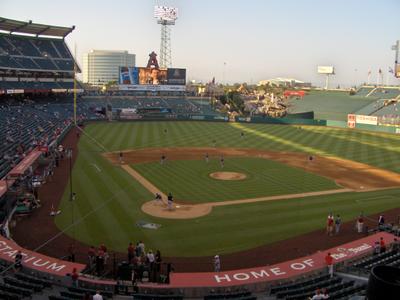
It's summertime here in Southern California. And with two local MLB franchises along with three others in-state, cable-TV with various sports networks, a Chicago network and another that tracks Atlanta there's always something on to indulge my obsession with this game. But there's seriously nothing like getting out to a see a game in person.
Angel Stadium in Anaheim is great. Having only ever been to games played in covered or retractable roof stadiums I was surprised by difference in the acoustics of this wide-open structure. There was a close play that resulted in an out in the bottom of the 9th and the sound of the crowd voicing their displeasure along the third-base side was surprising as the sound seemed to amplify like a giant bull-horn focused onto the field. From my perspective the sounds of the game and the crowd seemed to travel well with relatively little reflection from the architectural structure. They're also pretty light on playing canned-music through the PA system which makes for a better baseball experience in my opinion.

It was the Seattle Mariners versus the Los Angeles Angels as the "old" hometown team took on the "new." With the All-Star Bartolo Colon looking for his 12th win against Joel Pineiro seeking his first win since April it was surprising to watch the Mariners jump out to a big lead early. Colon was having an off night as he gave up several walks that ultimately allowed five runs to score in the first inning. Pineiro, on the other hand, had excellent location and gave up only six hits over the course of pitching a complete game. In the end it was Seattle 10, LA Angels 2 in a quick game that ran less than two and a half hours.
There's something satisfying about the clockwork precision of major league defensive plays as they get turned with 99% accuracy and the competitive hustle of running down foul balls. There was one broken bat ground-out that split the wood long-wise with a distinct sound that caught my ear. And the pop of a 94-mile-per-hour pitch landing in the catchers glove has its own resonant quality. I could get used to this kind of lazy, outdoor summertime scene.
Thursday, July 07, 2005
Wednesday, July 06, 2005
Tuesday, July 05, 2005
Monday, July 04, 2005
Holy Holy Holy Ghost - Chapter 7
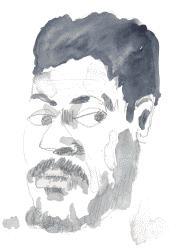 Diving back into the Holy Ghost box set of Albert Ayler today I focus on disc 7, which is some of the most challenging listening yet from a production quality standpoint. But it's also some sonically untethered improvising as well as the cavernous interiors of these live venues augments the "out there" quality of this music.
Diving back into the Holy Ghost box set of Albert Ayler today I focus on disc 7, which is some of the most challenging listening yet from a production quality standpoint. But it's also some sonically untethered improvising as well as the cavernous interiors of these live venues augments the "out there" quality of this music.The first two tracks are from January, 1969 as the Don Ayler Sextet plays at Town Hall, New York City. Don Ayler plays trumpet and much of the time his sound overwhelms the ensemble balance as the entire group sounds as if they're in a far corner of an empty gymnasium. After some acclimation to the poor recording quality one can feel the spirit of the playing and detect the burning energy Albert Ayler pours through his horn. This is more "evidence" of great playing and ideas than a polished, faithful replication of it. I am curious to learn more about the Don Ayler compositions of "Prophet John" and "Judge Ye Not."
The remainder of the disc focuses on some Albert Ayler Quintet material from La Colle sur Loup, Saint-Paul-de-Vence, France. The liner notes indicate that the date was "probably" July 1970. The sound quality is rough, but much better than the earlier portions of this disc. Though here the free improvisation feels a bit "lost" to my ears. In between solid, confident forceful bursts of energy Ayler seems to lapse into a bewildered searching sound. The drumming is excellent and
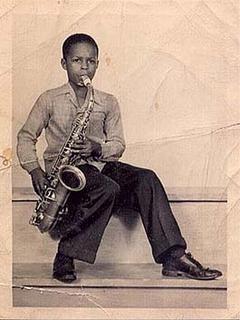 the "barely there" piano feels wildly out of place. Ayler seems to layer a wailing scream over the top. Knowing now that time was running out on Ayler's mortality lends an unsettling quality to this material. What kind of figure would he become if allowed to continue on longer? What aesthetic directions would he have pursued if he had followed his spiritual quest toward new degrees of understanding or was he running right up to the edge of sanity? Ayler's music has not been forgotten as questions about what might have been add several layers as succeeding generations of creative improvisers attempt to learn from this radical forbearer.
the "barely there" piano feels wildly out of place. Ayler seems to layer a wailing scream over the top. Knowing now that time was running out on Ayler's mortality lends an unsettling quality to this material. What kind of figure would he become if allowed to continue on longer? What aesthetic directions would he have pursued if he had followed his spiritual quest toward new degrees of understanding or was he running right up to the edge of sanity? Ayler's music has not been forgotten as questions about what might have been add several layers as succeeding generations of creative improvisers attempt to learn from this radical forbearer.With a box set that pulls together previously unreleased and rare recordings of a subject like Albert Ayler one has to expect at least one disc of rough material like this one. This is material strictly for those who can hear beyond production and hear the music lurking within this unique soul. The first five or so discs of Holy Ghost are a treat to hear while this late disc tells a story of Ayler's struggles late in his short life and present a brilliant artist struggling to push forward through severely uncharted territory.
Sunday, July 03, 2005
Independence Day Program
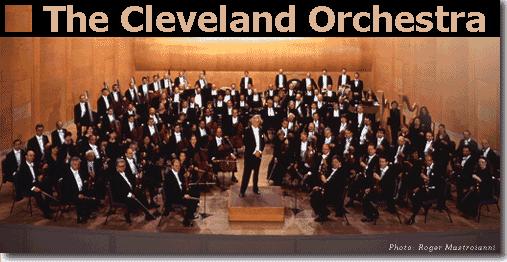
As an observance of some of the best expressions of patriotism and independence over this long weekend I put on a fine CD recorded by the Cleveland Orchestra and Chorus circa 1994 conducted by Christoph von Dohnanyi (with Jahja Ling listed as the "second conductor" for the one piece that requires two and Gareth Morrell as the director of the chorus).
 This program begins with a well-rehearsed performance of Ameriques by Edgard Varese. Imaginatively stretching the boundaries of symphonic timbre and language this incredible piece employs a huge battery of percussionists to paint an ambitious sonic landscape. I prefer the original version composed in 1918-1921 (performed magnificently by the Royal Concertgebouw Orchestra on Varese: The Complete Works), but this scaled-down version is impeccably executed and a satisfying dose of Varese's unique sound. This piece is widely regarded as Varese's first work in the style that would become so identifiably his own. It is fitting that Varese regarded the title as a reference to "symbolic of discoveries -- new worlds on earth, in the sky, or in the minds of men." The way these jagged sonic pieces fit together - part contra puntal texture, part Varesian percussive sensibility - rewards the attentive listener and alludes to discoveries still left unexplored almost a full century later.
This program begins with a well-rehearsed performance of Ameriques by Edgard Varese. Imaginatively stretching the boundaries of symphonic timbre and language this incredible piece employs a huge battery of percussionists to paint an ambitious sonic landscape. I prefer the original version composed in 1918-1921 (performed magnificently by the Royal Concertgebouw Orchestra on Varese: The Complete Works), but this scaled-down version is impeccably executed and a satisfying dose of Varese's unique sound. This piece is widely regarded as Varese's first work in the style that would become so identifiably his own. It is fitting that Varese regarded the title as a reference to "symbolic of discoveries -- new worlds on earth, in the sky, or in the minds of men." The way these jagged sonic pieces fit together - part contra puntal texture, part Varesian percussive sensibility - rewards the attentive listener and alludes to discoveries still left unexplored almost a full century later.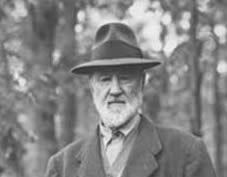 Next up on the Independence Day program is Symphony No. 4 by Charles Ives. This piece is a great contribution to the symphonic canon by an icon who advanced American art music early in the 20th Century. This is the work where Ives uses two conductors to recreate the sound of two marching bands playing independently as they march toward one another. The polytonal, polytempo sound is anchored by the use of quoted materials. Hymn tunes and military marches are used to paint a fond sonic image of the New England of Ives's youth without becoming sentimental.
Next up on the Independence Day program is Symphony No. 4 by Charles Ives. This piece is a great contribution to the symphonic canon by an icon who advanced American art music early in the 20th Century. This is the work where Ives uses two conductors to recreate the sound of two marching bands playing independently as they march toward one another. The polytonal, polytempo sound is anchored by the use of quoted materials. Hymn tunes and military marches are used to paint a fond sonic image of the New England of Ives's youth without becoming sentimental.The Independence Day program then concludes with The Unanswered Question by Chales Ives. This is a short symphonic work that features a solo trumpet line that sounds unresolved, like a question. This is one of my favorite Ives compositions and this performance sounds a little timid. The New York Philharmonic/Leonard Bernstein recording from 1990 is much more satisfying and I find myself reaching for that version once this disc has run out.
-----------
The Dallas Morning News ran this miserable article by Scott Cantrell as part of its Independence Day observance. There have been several articles and blogs about the "gay American" sound spurred by the recent publication of The Queer Composition of America's Sound: Gay Modernists, American Music, and National Identity by Dr. Nadine Hubbs.
The idea that homosexual identity = consonant tonality / heterosexual identity = dissonant atonality is incredibly insulting. And it offers yet another excuse for journalists and writers to write poorly or not at all about how music actually sounds. Sexual orientation is one thing. Musical aesthetics is another. It's artificial to assume that one has anything to do with the other. Dr. Hibbs tries to get off the hook by acknowledging the exceptions (such as "dissonant gay" composers like Henry Cowell or John Cage or "consonant straight" composers like Roy Harris or Walter Piston) but ultimately excludes them as anomalies. Actually, these "exceptions" point toward a significant weakness of the entire premise. You can argue any stupid thesis if you cherry-pick your supporting evidence. These exceptions are really exclusions as the set of American composers sited is absurdly small and heavily slanted. If you actually included a full range of American composers one would immediately see the absurdity of trying to pigeon hole a singular correlation between aesthetic and orientation. This is especially true when you consider composers who have adopted any number of different aesthetic positions over the course of their career while their orientation remained static.
Several lines from the Cantrell article are breathtakingly ignorant. Such as: "Arnold Schoenberg and his followers constructed music by mathematical formulas rather than sound." He apparently believes that statement requires no supporting evidence. Having actually heard the music of Arnold Schoenberg I find it hard to believe his harmonic innovations weren't motivated by sonic reality. One should say "Cantrell and his ilk write music opinion based on social prejudice rather than sound." The fact that so many of Schoenberg's contemporaries independently arrived at similar harmonic approaches at about the same time indicates that he was part of a natural growth toward extending harmony in the wake of Romanticism's reliance on chromaticism. One could work this idiotic logic backwards to condemn the "numerical dependence" of Beethoven's triadic harmony or Bach's canons. It's maddening that Cantrell can somehow see into the motivation of "Schoenberg and his followers" but cannot say one word about how it actually sounds. If there's a Pierrot Lunaire or Ewartung equation I would love to see it. After all, I've been listening to those "equations" for years now.
Another line of pure ignorance: "Melody and consonance were replaced by spiky disjunction, harmony by dissonance." This one doesn't make logical sense as "consonance" and "harmony" are not interchangeable terms. Harmony includes both 'consonance' and 'dissonance.' He might as well have said "color is replaced by orange." Or, given the sexual orientation-tilt of this article he could replace it with "pink" and keep on painting in gross stereotypes and generalizations.
-------------
Happy Independence Day.
Saturday, July 02, 2005
Returning to the Holy Ghost - Chapter 6
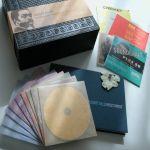
I'm making that spiritual pilgrimage back to the Revenant Records Holy Ghost Box Set of Albert Ayler. This time landing on disc 6. This time the focus is on the period from 1967 - 1968. It's frightening to think how much time was ticking away from Ayler's much-too
 short life at this point.
short life at this point.Kicking off with an invocation of aggressive poise we hear the Albert Ayler Quintet from a 1967 summer set in Freebody Park: Newport, Rhode Island playing "Truth Is Marching In/Omega." This one is for a congregation that understands that expressions of the soul can have a hard edge. The addition of Milford Graves on drums for this set adds a welcome component to this sound. He would later record the incredible Love Cry (which is very much on my short list of great jazz listening experiences) with Ayler that same year. This quintet is confident and relentless.
Then we come to track 4: "Love Cry/Truth Is Marching In/Our Prayer" performed at the funeral of John Coltrane on July 21, 1967 at St. Peter's Lutheran Church, New York City. This was a grim loss in a period that was unusually full of such
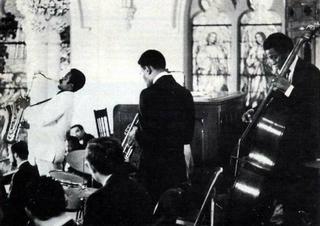 losses of forward-thinking individuals in music, politics and civil rights. Here Ayler's sound is somberly enclosed within the acoustically reflective space of the chapel. The sound of love and mourning are readily apparent as Ayler's compositions and sensibility are heard physically imposed and tempered within a house of worship for the first time (for my ears). The love and respect for this fallen colleague and hero is clearly audible. High praise is due to Revenant Records for releasing this six minute glimpse of one great spiritual journeyman paying homage to another.
losses of forward-thinking individuals in music, politics and civil rights. Here Ayler's sound is somberly enclosed within the acoustically reflective space of the chapel. The sound of love and mourning are readily apparent as Ayler's compositions and sensibility are heard physically imposed and tempered within a house of worship for the first time (for my ears). The love and respect for this fallen colleague and hero is clearly audible. High praise is due to Revenant Records for releasing this six minute glimpse of one great spiritual journeyman paying homage to another.In the wake of this tribute to "the father," we then turn to a 1968 set by the Pharoah Sanders Ensemble with Albert Ayler in New York City. Here the energy erupts at full intensity. The saxophone crosses over completely into a full human scream. Here Ayler's improvisation and intensity seems to overwhelm the ensemble sound as "Upper and Lower Egypt" recedes into the background. I suspect the microphone is simply too close to Ayler on this recording as the audience sounds enthusiastic and engaged with this performance.
Disc 6 then closes out with a series of recordings from late August of 1968. Some of them demo fragments. These tracks are a puzzle. The energy is different on these tracks as they take on self-consciously polished quality while losing much of the live energy from the Quintet takes from this and earlier discs in this box set. Though I am struck and just how different Ayler accompanied by piano sounds compared to Coltrane with piano. Ayler's improvisation style really does require a Cecil Taylor-esque presence behind the keys. The session players solidly supplying the blues changes underneath just don't seem to match or interact with Ayler's extreme range. I am genuinely perplexed by the brief sermon delivered by Ayler and the awkward vocals of "Thank God for Women" over a decidedly straight rock beat. Here I suspect his creative searching was teetering between the cul-de-sac of convention and exhaustion from the spiritual journey pursued thus far. Though hearing lyrics applied to the melodic line of "Ghosts" is an intriguing revelation.
Subscribe to:
Comments (Atom)















